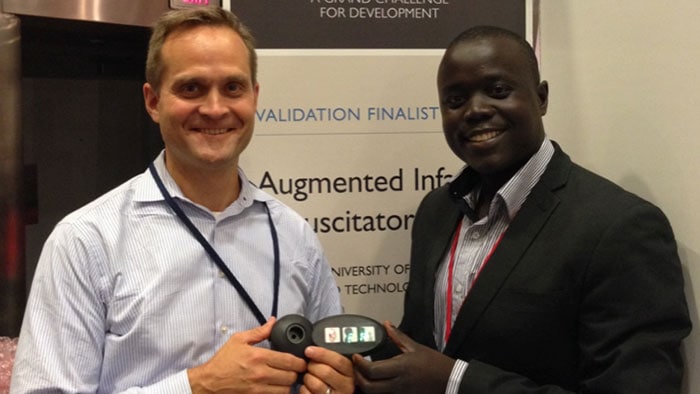Sep 26, 2018
Philips and global healthcare leaders develop innovative resuscitation device to help reduce neonatal mortality
Amsterdam, the Netherlands and New York, NY – On the occasion of the 73rd Session of the United Nations General Assembly (UNGA 73), Royal Philips (NYSE: PHG, AEX: PHIA), a global leader in health technology, today announced the successful development of the ‘Augmented Infant Resuscitator (AIR)’ – an add-on device for conventional neonatal bag-valve-mask (BVM) resuscitators that helps care givers to effectively resuscitate asphyxiated newborn babies. Developed in collaboration with the Consortium for Affordable Medical Technologies (CAMTech) at Massachusetts General Hospital Global Health, the Philips Augmented Infant Resuscitator aims to reduce neonatal mortality, especially in parts of the world that are underserved in terms of healthcare. It is expected to be available in limited volume in selected markets prior to scaling up availability in low- and middle-income countries. Birth asphyxia’s global impact Birth asphyxia is a medical condition caused by prolonged deprivation of oxygen to a newborn during the birth process, resulting in damage to vital organs, usually the baby’s brain. Globally, birth asphyxia causes more than 800,000 neonatal deaths annually, and over one million potentially preventable reported stillbirths1. Effective resuscitation could reduce birth asphyxia related neonatal deaths by 30 percent, and deaths from prematurity by 10 percent2. However, one-in-five trained healthcare professionals fail to perform the resuscitation technique correctly, and those that do often experience a rapid decline in proficiency3. Effective resuscitation through innovation The AIR device is an innovative add-on that is compatible with virtually all existing manual bag-valve-mask resuscitators. It has the potential to significantly improve the initial training and ongoing practice of bag-valve-mask resuscitation skills. The device measures ventilation flow and pressure to monitor the quality of ventilation, and provides intuitive visual feedback on common ventilation errors, including inadequate face-mask seal, obstructed airway, incorrect ventilation rate, and harsh breaths that can damage the baby’s airways. Any one of these mistakes may result in death or permanent neurological injury. The AIR also records performance for future feedback, improving the training of healthcare professionals by identifying persistent gaps in technique. “At Philips, we aim to improve people’s health through meaningful innovations,” said Arman Voskerchyan, Business Leader for Therapeutic Care at Philips. “Our mission is to improve the lives of three billion people a year by 2025. By combining our expertise in respiratory care and resuscitation with the strengths of global health innovators like the AIR team at CAMTech, we aim to drive and scale innovative solutions that bridge societal divides in healthcare to reach underserved populations, and thereby addressing the United Nations Sustainable Development Goal 3.” Recent history of AIR Dr. Kristian Olson, Director of CAMTech at Massachusetts General Hospital Global Health, Dr. Data Santorino, CAMTech Uganda Country Manager, and Dr. Kevin Cedrone, a lecturer at the Massachusetts Institute of Technology (MIT), first created the AIR device prototype in 2012 at a CAMTech Hack-a-thon with MIT at Massachusetts General Hospital. After receiving an initial grant from CAMTech in early 2013, further development and testing of the AIR device was supported by Saving Lives at Birth (SLAB) – A Grand Challenge for Development partners. In late 2016, the AIR team completed a multi-center randomized trial of 270 birth attendants in both Uganda and the US, details of which will be presented in a future publication. Next steps Since 2016, Philips and the AIR team have further developed the device. Philips recently obtained a license for the relevant Intellectual Property owned by Partners Healthcare and Mbarara University of Science and Technology, to commercialize and scale the Augmented Infant Resuscitator device. CAMTech will continue to gather new impact, usability and cost-effectiveness data through a multi-country trial in India, Uganda and Ghana, for which Philips will provide CAMTech with more than 200 engineering samples. 1 http://www.thelancet.com/pb/assets/raw/Lancet/stories/series/stillbirths2016-exec-summ.pdf 2 Wall SN, Lee AC, Carlo W, Goldenberg R, Niermeyer S, Darmstadt GL, et al. Reducing intrapartum-related neonatal deaths in low- and middle-income countries-what works? Semin Perinatol 2010 Dec; 34(6):395-407. 3 Patel J, Posencheg M, Ades A. Proficiency and retention of neonatal resuscitation skills by pediatric residents. Pediatrics 2012 Sep; 130(3):515-521.
About Royal Philips
Royal Philips (NYSE: PHG, AEX: PHIA) is a leading health technology company focused on improving people's health and enabling better outcomes across the health continuum from healthy living and prevention, to diagnosis, treatment and home care. Philips leverages advanced technology and deep clinical and consumer insights to deliver integrated solutions. Headquartered in the Netherlands, the company is a leader in diagnostic imaging, image-guided therapy, patient monitoring and health informatics, as well as in consumer health and home care. Philips' health technology portfolio generated 2017 sales of EUR 17.8 billion and employs approximately 74,000 employees with sales and services in more than 100 countries. News about Philips can be found at www.philips.com/newscenter.
Topics
For further information, please contact:

Kathy O'Reilly
Philips Global Press Office Tel.: +1 978-221-8919
You are about to visit a Philips global content page
ContinueMichael Morrison
Massachusetts General Hospital Press Office Tel.: +1 617-724-6425
You are now exiting the Philips United States (US) site and entering the Philips global site. This content is intended for a global audience. It may not apply to the US and should not be interpreted as meeting US standards, executive orders or regulations.
Continue


